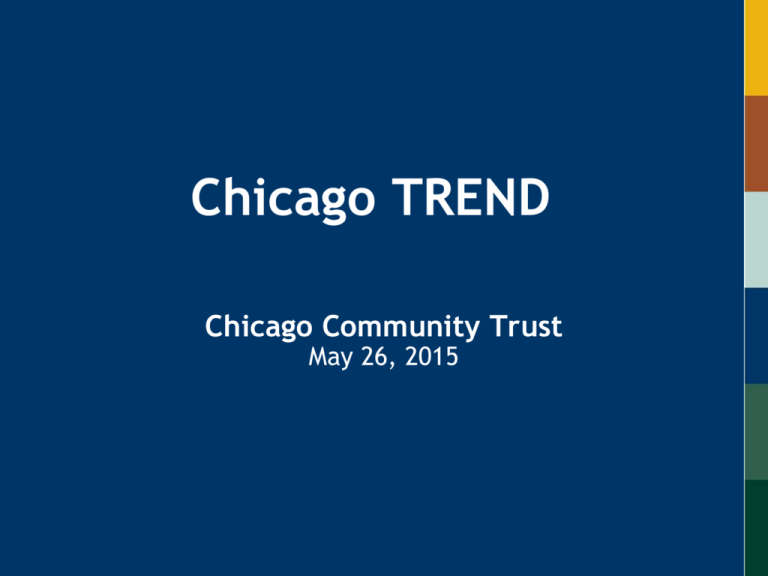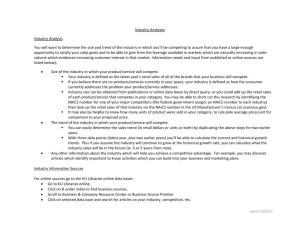presentation - RW Ventures
advertisement

Chicago TREND Chicago Community Trust May 26, 2015 Origins The TREND Concept: Using Retail “Plus” to Drive Neighborhood Development Current Neighborhood Status Retail The Sweet Spot: Where Retail Accelerates Neighborhood Transformation Neighborhood Trajectories 3 RETAIL DEVELOPER AND BROKER ENGAGEMENT Local Field Work Completed 1. Tom Bernier, Bucksbaum Retail Properties; 2. David Doig, CNI; 3. James Matanky, Matanky Realty Group; 4. Paul Stewart, Capri Capital; 5. Leon Walker, DL3 Realty; 6. Rich Warren and Randy Ross, Community Development Strategies; 7. Ken Gold, Skilken; 8. Michael Marchese, Harlem Irving Companies; 9. Edmund Woodbury, McCaffery Interests; 10. Richard Tucker, Tucker Development; 11. David Baum, Baum Realty; 12. Todd Cabanban, Cabanban, Rubin, & Mayberry; 13. Lauren Lowry, Finders Plus, 14. Mike Mallon, DKMallon Developer Broker Meeting Held on May 12, 2014 Meetings with Representatives of LISC, MPC, WBC, DPD, Illinois Restaurant Association, Bronzeville Retail Initiative, Chatham Business Association, Cook County Land Bank, etc. RETAIL DEVELOPER AND BROKER ENGAGEMENT National Field Work Completed 1. Big Boxes – Target, Walmart, Petco, Marshalls, Meijers 2. Specialty – Starbucks, Chipotle, Studio Movie Grill, Kumon, UPS Store 3. Restaurants – Panera Bread, Buffalo Wild Wings, Famous Daves, Macoroni Grill, Del Taco, Culvers, Moes Southwest Grill, Jimmy Johns, Bloomin Brands 4. Others – Save a Lot, Sears, Walgreens, CVS Attended ICSC Convention May, 2014 and 15 (met with 34 retailers and introduced Chicago TREND to the ICSC National Underserved Markets Initiative Committee) Strategy How Retail+ Can Lead: Getting to Strategic, Viable, Scale THE TREND TOOLBOX Market Research, Analytics and Products Leadership and Coordination; “Master Deal Broker” Retailer Attraction Focused Financial Tools Shopper Survey Completed Online Survey Survey firm (6,000 surveys) The Chicago Rehab Network (1,200 surveys) 20 community/neighborhood organizations and community colleges (800 surveys) 50 local blogs Traditional media outreach campaign New survey to be conducted in 2015 8 Survey coverage – race distribution Shopping destinations outside neighborhood DNT taxonomy – updated DNT taxonomy/typology reapplied to Chicago neighborhoods using updated 2010 data, to examine how neighborhoods changed from 2000-2010 23 input variables contributing to this classification: People Housing & Land Use Business Median household income % single family detached # unique business types Income Diversity % vacant housing units # social capital (normalized by population) Age Structure (% 0-18, % 1934, % 35-64, % 65 plus) % owner occupied housing units % retail businesses with more than 20 employees % single parent households Median age of housing structures # retail establishments normalized by land area % foreign born % residential parcels # services normalized by land area % households moved in less than 5 years % industrial parcels # entertainment normalized by land area % households moved in over 10 years % vacant parcels Taxonomy Structure lower income higher income URBAN TAPESTRY DNT taxonomy – transition 2000-2010 Transition Matrix – Chicago, 2000 to 2010 Count in 2010 5 87 167 97 176 7 142 92 18 9 3 4 5 6 7 8 1 23.08 53.85 15.38 0.00 7.69 0.00 0.00 0.00 0.00 13 2 1.12 49.44 30.34 0.00 15.73 1.12 1.12 1.12 0.00 89 3 0.73 16.79 77.37 0.00 1.46 0.00 3.65 0.00 0.00 137 Port of Entry 4 0.00 2.26 0.75 57.14 36.09 0.75 0.75 2.26 0.00 133 Urban Tapestry 5 0.00 5.30 5.30 11.36 61.36 0.76 6.06 9.09 0.76 132 Coming Attractions 6 0.00 0.00 0.00 10.53 26.32 5.26 10.53 47.37 0.00 19 No Place Like Home 7 0.00 0.00 10.60 0.66 9.27 0.00 78.81 0.00 0.66 151 Close, Cool and Commercial 8 0.00 3.30 7.69 3.30 8.79 2.20 2.20 68.13 4.40 91 Fortune 100 9 0.00 0.00 3.85 0.00 11.54 Truly Disadvantaged Transient Underdeveloped Stable Low Income 1 2 Count in 2000 Types in 2000 Types in 2010 3.85 15.38 19.23 46.15 26 13 Services Services: Identifying Opportunity, Facilitating and Expediting Development Bring “Big Data” to Neighborhood Retail Development Identify neighborhood trajectories, high-impact and market-viable retail Master Broker and Expediter Nexus of information and networks, connecting developers, retailers, community organizations Leverage synergies between retail opportunities and non-retail private and public investments (“Retail Plus”) Work with City departments to expedite strategic deals Retail Coalition of the Willing Organize and nurture retailers interested in locating in urban neighborhoods, similar to a trade organization Develop and implement co-tenancy and clustering strategies to reduce risk Discussion Draft 15 Trend Tool Concepts Tenant Attraction Program Facilitating Retail Development Typical Retail Development Process in Chicago for Projects More Than 150,000 SF Step Typical Time Required Can Trend Help? Market Analysis 1-3 Months YES Site(s) Identification, Due Diligence & Final Selection 2-6 Months YES Preliminary Financial Feasibility Analysis & Financial 1-2 Months YES Site Control 2-10 Months YES Preliminary Design & Cost Estimates 2-4 Months Secure Pre Development Financing 2-4 Months YES Anchor Tenant Letters of Interest (40-50% SF) 3-6 Months YES Approvals, Entitlement Process 4-8 Months YES Securing Tenants Leases 3-12 Months YES Design, Construction Bids 1-3 Months Final Financial Feasibility Analysis 1-2 Months Obtain Firm Financial Commitments 2-3 Months YES Securing Permits 2-6 Months YES Close on Property & Financing 1-4 Months YES Construction and Construction Management Marketing, Final Leasing Opening: Total Time from Initial Market Assessment 12-18 Months 3-5 Months YES 42-96 Months YES Coalition of the Willing – The Big Guys Trend Tool Concepts Anchor Attraction Credit Tenants 25,000+ SF Coalition of the Willing – Special Second Store Expansion Trend Tool Concepts Well Run Local Favorites Add Interest to Mix Support Entrepreneurial Growth Coalition of the Willing Sit-down National Restaurant Franchises Trend Tool Concepts Now Spending Leaves City Operator Identification and Training Liquidity and Net Worth Coalition of the Willing Alternative Tenants Trend Tool Concepts Non-retail tenants to round out mix Service Oriented Establishments Gap Financing Program Trend Tool Concepts Subordinate Loans for Retail Development Flexible to Secure Key Retailer Patient (20 year term) but Higher Return (5%) $1M Maximum Per Project Provided to developers for predevelopment costs, construction costs, tenant improvements. Could cover development of outlots or tenant improvements. Tenant Attraction Program Trend Tool Concepts $2M Recoverable Grant Program Rent Subsidy to Attract Desired “Key” Tenants Up to $500,000 per tenant lease over five year term The maximum annual rent subsidy will be based on a five year declining scale of $5-$4-$3-$2-$1. (For example – for a 5,000 sq. ft. retail space the incentive would be $25,000; $20,000; $15,000; $10,000; $5,000 for a total of $75,000) Provided to developers or landlords to pass on to tenants to subsidize costs during first five years. Funds can be used for tenant improvements or to cover for low sales. Neighborhood Retail Equity Fund Trend Tool Concepts $50M Fund; $10M invested by Chicago TREND Established Real Estate Equity Fund to be GP Partner; Chicago TREND to be LPs. Initiate Projects with Refined Market Data and Predictive Analytics (Master Deal Broker) Attract Developers and Retailers on the Leading Edge Higher Risk and Higher Equity Return Neighborhood Retail Bank Debt Program Trend Tool Concepts $10M Loan Program for Small Retailer Expansion or Improvement (working capital, tenant fit out, equipment;) Consortium Banks to invest $8M; $2M invested by Chicago TREND (25% subordinate loan participation) $250,000 maximum loan amount Implementation Plan and Goals Milestones By end of Year 1: Organizational milestones: ● Steering committee organized and meeting ● Fiscal agent and host agent selected and operational ● Investment and operating policies developed and approved ● Staff positions filled ● Contracts and operating procedures finalized with service providers ● Phase I financial tools operational Discussion Draft 27 Milestones By end of Year 1: Development milestones: ● 8,500 additional Shopper Choice survey responses received and the results incorporated into models and analytic tools ● Complete estimation of shopper and neighborhood choice models and simulation tools to predict impact of investments on shopper choices, neighborhood attributes, and neighborhood trajectory ● Retail Coalition of the Willing operational, albeit informally ● Recommendations delivered to at least two developers about types of retailers to solicit to lease uncommitted space and achieve desired community change ● Provide data and offers of financial assistance that leads to new leases at developments currently underway or infill in priority commercial corridors Discussion Draft 28 Milestones By end of Year 2: Organizational milestones: ● Partners identified for Phase II financing tools and formalized by memoranda of agreement ● Strategy, services and priorities re-assessed and recommendations prepared for funders ● Phase II funding secured Discussion Draft 29 Milestones By end of Year 2: Development milestones ● Predictive model developed and tested ● Retail Coalition of the Willing formalized and functioning ● Commit or fund approximately $5 million in financing to impact three strategic neighborhood retail developments and directly secure an estimated 13 key retail tenant leases ● Working with City of Chicago and Cook County officials for expediting approvals, licenses, land assembly, etc. Discussion Draft 30 Organization Structure and Governance Founding Entrepreneur: Lyneir Richardson Executive Director, Center for Urban Entrepreneurship and Economic Development, Rutgers Business School, Newark, NJ (current) Chief Executive Officer, Brick City Development Corporation, Newark, NJ (2009-2014) Vice President-Urban Development, General Growth Properties, Inc., Chicago, IL (2004-2009) Founder, Lakeshore Development & Construction Company, Chicago, IL (1995-2004) Vice President, Thrush Construction, Inc., Chicago, IL (1993-1995) Attorney, First National Bank of Chicago, Chicago, IL (1990-1993) Entrepreneurial projects include consulting and commercial real estate advisory services for property owners 32 Organizational Structure Steering Committee of 15-20 members representing retailers, developers, brokers, CBOs, investors and banking partners, city, data partners, civic and trade organizations. Steering Committee Fiscal Sponsor/Agent Executive Director Partners Staff Financial or Banking Financial Analyst Data Data Analyst Legal Admin Assistant Lead Partners: ICSC, Neilsen, LISC, ULI, CCLF,, Econsult, RES, …. Discussion Draft 33 Organization and Ecosystem Civic and Community Organizations Public Sector Steering Committee (Investors) CHICAGO TREND (4 people) Data and Financial Tools Retail and Mixed-Used Developers Retailers (Coalition of the Willing) Retail Brokers Banks Accelerating Desired Neighborhood Transformation Core Staffing; Distributed Product Delivery; Fiscal Agent Next Steps / How You Can Help Identify pilot projects with goal of making first investments in approximately six months Identify and help secure key retailer engagement (e.g. Walgreens, Chipotle, Starbucks, FedxOffice, Target, TGI Fridays) Identify potential members and help establish Steering Committee -senior leadership with credibility, relevant expertise, key partners Seek lead operating partners to administer financial products in first and second phase Engage bank, additional foundation, retailer, other investors: secure PRI loan and fund operating grant Discussion Draft 35 Chicago TREND Chicago Community Trust May 26, 2015





![[Company Name]](http://s3.studylib.net/store/data/009539562_1-20bba15a42c559f6e2eb5e3c0022265d-300x300.png)
